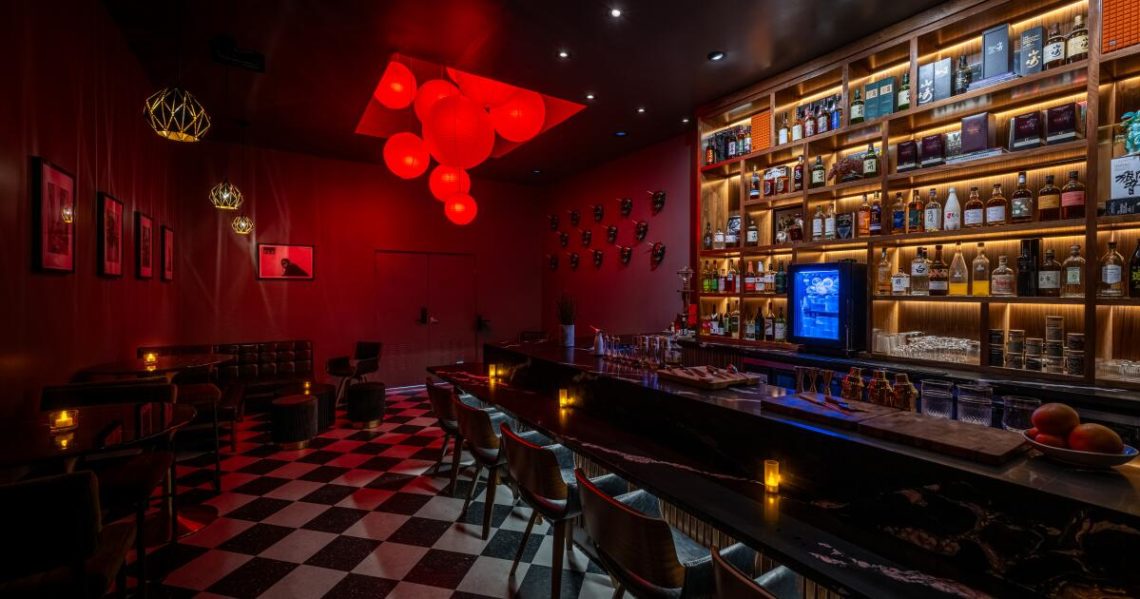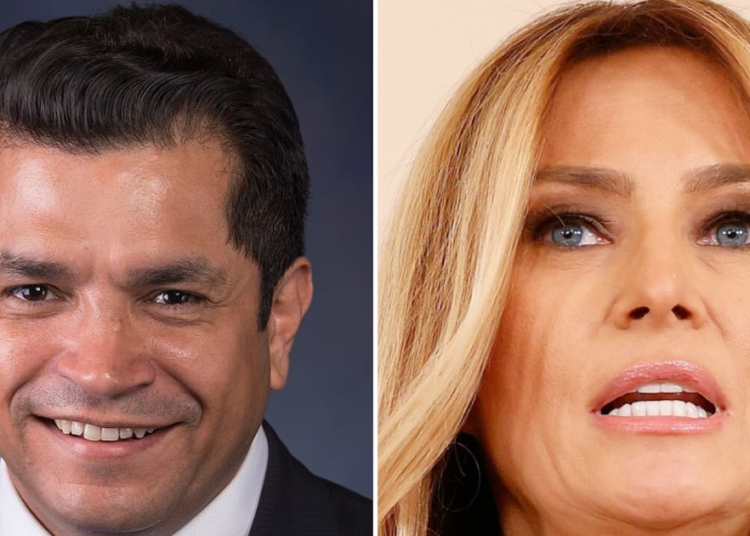A bartender pulls a daikon radish from a sink behind the bar at Tokyo Noir, a small speakeasy off 4th Street in Long Beach. The vegetable is more than a foot long, and the width of the barrel of a baseball bat.
“Is that for my cocktail?” I ask.
He offers a firm nod, then proceeds to grate the radish, releasing its pungent, peppery aroma into the air. Its snow white shaft seems to glow in the dark. The room is dim enough to make your pupils dilate.
The daikon in question is a garnish for the Dirty Soba, a cocktail served in the sort of soup bowl reserved for miso soup at your local Japanese restaurant. Remove the top of the bowl to reveal a shiny, smooth square of ice swimming in a mixture of bonito dashi, Iichiko shochu, buckwheat shochu, gin, sake vermouth and yuzu. On top of the ice sits a small pile of the freshly grated daikon. The bartender instructs me to first sip the cocktail on its own, then use the provided wooden spoon to stir in the daikon.
The drink is intensely savory, nearly on the edge of too earthy, but the yuzu yanks it back into balance. Each sip is beautifully layered with woody mushrooms and konbu from the dashi, and with the warm, nutty notes of buckwheat. Stir in the daikon and there’s a burst of freshness from the radish, its bitterness slicing through the heavy layers of shochu.
The Dirty Soba, like the other dozen or so cocktails at the bar, has all the complexities and showmanship of a multicourse tasting menu.
Tokyo Noir is a speakeasy located about halfway down an alley behind El Barrio Cantina restaurant, with a green door under a glowing red lantern.
Co-owners Kevin Lee and Jesse Duron opened the bar in late 2024. Duron is the restaurateur behind El Barrio Cantina and Lee is a barman known for his innovative bar programs that highlight his homemade bitters, amaro, vermouth and liqueur. Lee previously ran the Wolves in downtown Los Angeles and designed a cocktail tasting menu for its sister concept Le Néant.
“The reason we created this bar is because we thought it would be something cool to bring to California, and there aren’t many Japanese-inspired cocktail bars,” says Lee. “Jesse is half Japanese, I’m familiar with Japanese bartending, and when he and I started talking we got really excited about doing something that looked and felt Japanese.”
Lee and Duron source Japanese whisky, shochu, gin and umeshu for the cocktails. Yuzu, Okinawa sugar and shiso also appear frequently on the menu. If you want to splurge on a finger of Hibiki 30 Yr or Yamazaki 25-year-old single malt, this is the place.
The drinks are made with crystal clear blocks of ice from the Japanese city of Kanazawa. Lee, who claims to be the only “certified ice master” outside of Japan, uses a knife to carve the ice blocks into spheres, squares and diamonds. The shapes are visually striking, but the curves and size of the ice also contribute to how quickly, or slowly, the ice melts in the drink.
The first sip of the Dirty Soba transports me to the dawn of the cocktail revolution in Los Angeles. It was 2009, and the Varnish had just opened its doors at the back of Cole’s in downtown Los Angeles. Founders Sasha Petraske, Cedd Moses and Eric Alperin introduced drinks made with hand-cut ice, artisanal spirits and farmers market produce and, in doing so, turned cocktail-curious Angelenos into serious connoisseurs.
Tokyo Noir embodies that same spirit of discovery and meticulous craftsmanship, with no limit to what Lee will do to achieve the desired alchemy in a glass. When Lee opened his first bar, Puzzle in La Mirada, he made all of his own bitters, amaro and vermouth. He experimented with different varieties of mint from local farms to make fernet.
The dashi used in the Dirty Soba at Tokyo Noir is sous vide overnight, made from matsutake mushrooms, bonito and konbu. The bar makes all its own bitters from scratch.
The drink menu resembles a food zine, with intricate illustrations and tasting notes for each cocktail.
“It was a big debate, because there are a lot of ingredients,” Lee says. “We don’t list everything because you’d be getting like 12 ingredients and five you’re not even going to taste because a lot of it is for layering the cocktails.”
Lee and his team tried to narrow down and highlight recognizable flavors for the drink descriptions.
The text that accompanies the Dirty Soba reads: Umami. Refreshing. Complex. A little oversimplified but spot on.
The
Initial B is: Bright. Dry. Bitter. The drink is actually a play on a Boulevardier, made with bourbon, white miso, Campari, sweet Japanese vermouth and banana liqueur.
“We use homemade aromatic bitters and also a little bit of our citrus bitters, too,” says Lee. “Oh, and we throw a little bit of tomato bitters in there as well. It was kind of based off of having a miso banana bread that I really liked.”
The drink is surprisingly warm, pleasantly bitter and balanced, with the banana mostly hovering in the background. It’s crowned with a square of Castella cake over the top. The bouncy, Japanese sponge cake provides a touch of sweetness and another fun textural element to the cocktail.
You could spend an evening sipping through the menu for dinner (with a designated driver, of course), beginning with something light and refreshing like the Okinawa Gimlet before moving on to the Dirty Soba or the Spine and Silk, a briny drink capped with a sea urchin foam.
Ulises Pineda-Alfaro, who is the chef at El Barrio Cantina next door, also put together a short menu of snacks to support Lee’s cocktails.
Spicy tuna temaki are dressed with a salsa macha ponzu. Corn ribs are rubbed with butter and soy and garnished with cotija crisps. Japanese corn dogs are zigzagged with Okonomiyaki sauce and Kewpie mayonnaise, then garnished with bonito flakes and serrano pepper.
With seasonality in mind and a creative ambition that never falters, Lee is already beginning to shift ideas and flavors for cooler weather. He intends to replace the Dirty Soba cocktail with a drink inspired by chawanmushi, the Japanese steamed egg custard, though I will mourn its absence.
The post The L.A. cocktail revolution begins again at this Tokyo-inspired Long Beach bar appeared first on Los Angeles Times.




